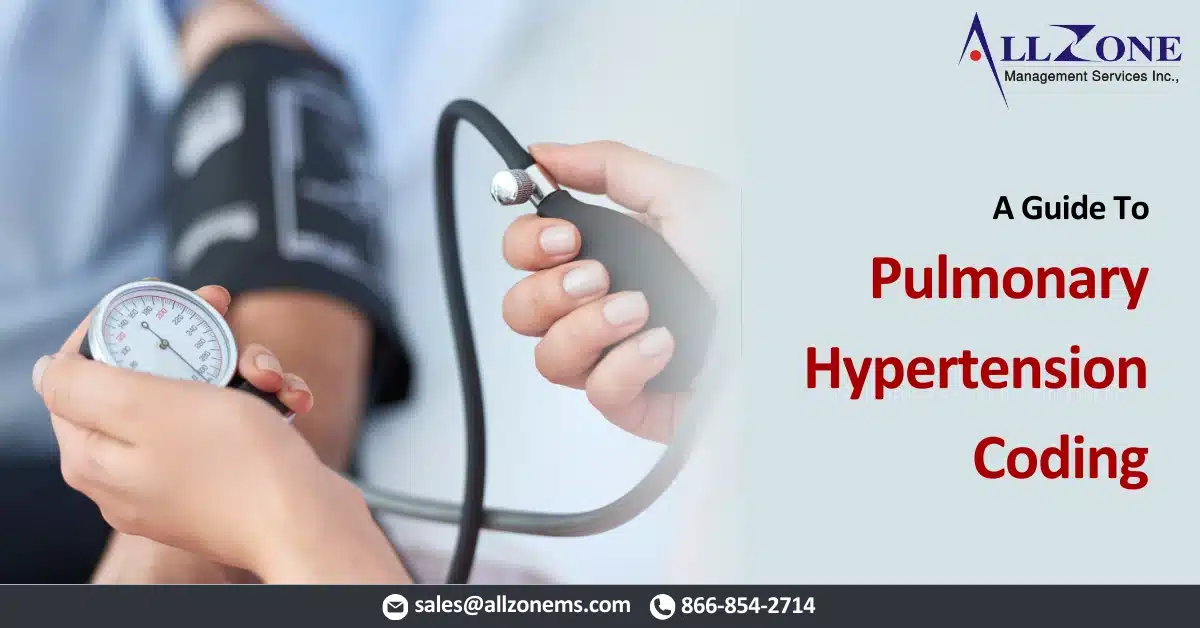Pulmonary hypertension (PH) is a “frequently identified, highly morbid condition” associated with increased mortality, hospitalizations, and significant financial burden. What steps can you and your provider take to ensure this condition is both documented and coded correctly?
Below are four strategies to improve your Pulmonary Hypertension coding practices.
1. Understand Pulmonary Hypertension (PH)
The Pulmonary Hypertension Association (PHA) defines PH as “a general term used to describe high blood pressure in the lungs from any cause.” This elevated pressure thickens the lung’s arteries, forcing the right side of the heart to work harder to pump blood into the lungs, ultimately leading to right-side heart failure.
The World Health Organization (WHO) categorizes PH into five groups (PH WHO Groups), which are crucial for coders. These groups help identify the condition’s cause and determine the appropriate ICD-10-CM codes for accurate documentation.
2. Know the I27 Category and PH WHO Groups
Group 1: Pulmonary Arterial Hypertension (PAH)
This group includes primary PH, also known as PAH, which is further divided into:
- Idiopathic PAH: No identifiable cause.
- Heritable PAH: A genetic condition.
- Other PAH: Linked to drug use, liver disease, connective tissue disorders (e.g., lupus), or HIV.
Associated ICD-10-CM Code: I27.0 Primary pulmonary hypertension
Group 2: PH Due to Left Heart Disease
The most common form of PH occurs when left heart problems cause blood to back up, raising pressure in the lungs.
Associated ICD-10-CM Code: I27.22 Pulmonary hypertension due to left heart disease
Group 3: PH Due to Lung Diseases and Hypoxia
This group includes PH caused by obstructive and restrictive lung diseases, such as:
- Chronic lung disease
- COPD
- Emphysema
- Interstitial lung disease
- Sleep apnea
- Hypoxia (low oxygen levels)
Associated ICD-10-CM Code: I27.23 Pulmonary hypertension due to lung diseases and hypoxia
Group 4: Chronic Thromboembolic Pulmonary Hypertension (CTEPH)
This form of PH results from lung blood clots that lead to scarring and restricted blood flow.
Associated ICD-10-CM Code: I27.24 Chronic thromboembolic pulmonary hypertension
Group 5: PH from Other Causes
A catch-all group for PH caused by less-understood conditions, such as:
- Sarcoidosis
- Sickle cell anemia
- Chronic hemolytic anemia
- Splenectomy
- Certain metabolic disorders
Associated ICD-10-CM Code: I27.29 Other secondary pulmonary hypertension
3. Understand the Coding Guidelines for I27
Code Also Instructions
Most PH groups (except Group 1) include “Code also” instructions, reflecting the need to document associated conditions or drug effects. For example, ICD-10 guideline I.C.9.a.11 states:
“Code any associated conditions or adverse effects of drugs or toxins for any of the secondary pulmonary hypertension codes (I27.-).”
Sequencing Considerations
Sequence codes based on the primary reason for the encounter unless adverse drug effects are involved. For instance, if a provider addresses a patient’s secondary PH caused by rheumatoid arthritis, you would:
- Code M05.- Rheumatoid arthritis first.
- Follow with I27.21 Pulmonary hypertension secondary to connective tissue disease.
4. Know the Excludes1 Notes for I27
Excludes1 notes clarify when two conditions cannot be coded together. Key examples include:
- ICD-10-CM Diagnosis Code I27.0: Cannot be coded with certain secondary PH conditions or P29.30 Pulmonary hypertension of newborn.
- ICD-10-CM Diagnosis Code I27.2-: Cannot be coded with I27.83 Eisenmenger’s syndrome, a congenital defect causing abnormal blood flow between the heart and lungs.
By mastering these strategies, you can ensure accurate documentation and coding of pulmonary hypertension, improving patient care and supporting proper reimbursement.
Pulmonary Hypertension ICD-10-CM Codes for 2025
Pulmonary hypertension is classified under specific ICD-10-CM codes, which are standardized diagnostic codes used internationally, including in India. As of 2025, the relevant codes for pulmonary hypertension are:
- ICD-10-CM Diagnosis Code I27.0: Primary pulmonary hypertension. This code encompasses conditions such as heritable pulmonary arterial hypertension, idiopathic pulmonary arterial hypertension, and primary group 1 pulmonary hypertension.
- ICD-10-CM Diagnosis Code I27.20: Pulmonary hypertension, unspecified. This code is used when pulmonary hypertension is diagnosed but not specified as primary or secondary.
- ICD-10-CM Diagnosis Code I27.21: Secondary pulmonary arterial hypertension. This includes pulmonary arterial hypertension associated with conditions such as congenital heart disease, HIV disease, portal hypertension, and exposure to drugs or toxins.
- ICD-10-CM Diagnosis Code I27.22: Pulmonary hypertension due to left heart disease. This code applies to group 2 pulmonary hypertension resulting from left heart conditions like multiple valve disease or rheumatic mitral valve diseases.
- ICD-10-CM Diagnosis Code I27.23: Pulmonary hypertension due to lung diseases and hypoxia. This includes group 3 pulmonary hypertension associated with lung conditions such as interstitial lung disease, sleep apnea, or cystic fibrosis.
- ICD-10-CM Diagnosis Code I27.24: Chronic thromboembolic pulmonary hypertension. This code is designated for group 4 pulmonary hypertension resulting from chronic blood clots in the lungs.
- ICD-10-CM Diagnosis Code I27.29: Other secondary pulmonary hypertension. This encompasses group 5 pulmonary hypertension due to unclear or multifactorial mechanisms, including hematologic, metabolic, or systemic disorders.
These codes are utilized for accurate diagnosis, treatment planning, and health insurance claims. It’s essential for healthcare providers to select the most specific code based on the underlying cause of pulmonary hypertension to ensure precise medical records and appropriate patient care.
Pulmonary Hypertension Coding Services in the USA
Pulmonary hypertension coding requires precision to ensure accurate documentation and optimal reimbursement. In the USA, specialized medical coding services like Allzone Management Services (Allzone MS) streamline this process by adhering to the latest ICD-10 and CPT coding guidelines. Accurate identification of primary and secondary pulmonary hypertension is critical, as incorrect coding can lead to claim denials or compliance issues.
Professional medical coding companies, including Allzone MS, employ certified coders with expertise in cardiopulmonary conditions, ensuring accurate representation of complex cases such as chronic thromboembolic pulmonary hypertension (CTEPH) or pulmonary arterial hypertension (PAH). Outsourcing these services not only reduces administrative burdens but also enhances revenue cycle efficiency by minimizing errors and expediting reimbursements.
Partnering with a trusted pulmonary hypertension coding provider like Allzone MS allows healthcare practices to focus on patient care while ensuring compliance with regulatory standards.
Leverage Allzone MS’s expertise to optimize your pulmonary hypertension coding processes today!

